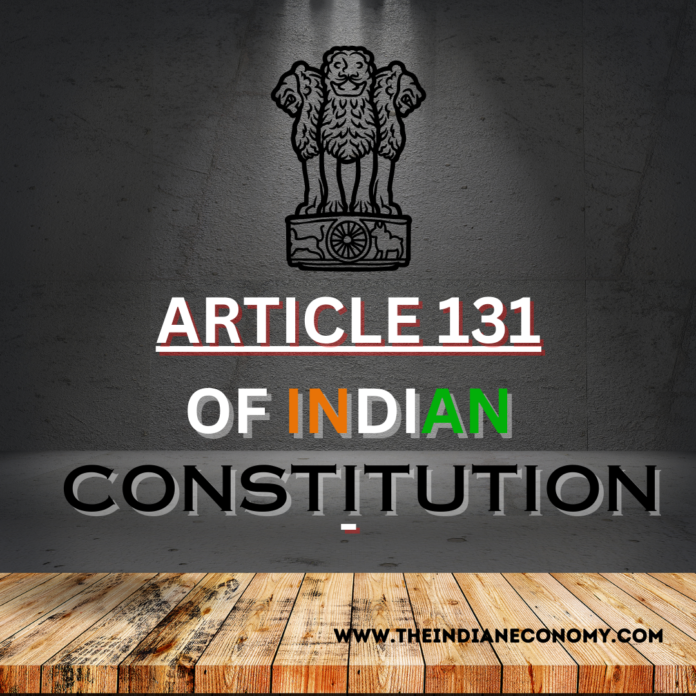Article 131 of the Indian Constitution delineates a distinctive and vital authority vested in the Supreme Court: its original jurisdiction. Titled “Original jurisdiction of the Supreme Court,” this article lays the groundwork for the court’s role in adjudicating disputes that involve not only the legal rights of states but also the federal structure of India’s governance. Within this constitutional provision lies the power of the Supreme Court to entertain disputes between the Indian government and individual states or disputes between states themselves.
What does Article 131 states ?
Original jurisdiction of the Supreme Court Subject to the provisions of this Constitution, the Supreme Court shall, to the exclusion of any other court, have original jurisdiction in any dispute
(a) between the Government of India and one or more States; or
(b) between the Government of India and any State or States on one side and one or more other States on the other; or
(c) between two or more States, if and in so far as the dispute involves any question (whether of law or fact) on which the existence or extent of a legal right depends: Provided that the said jurisdiction shall not extend to a dispute arising out of any treaty, agreement, covenant, engagements, and or other similar instrument which, having been entered into or executed before the commencement of this Constitution, continues in operation after such commencement, or which provides that the said jurisdiction shall not extend to such a dispute
Key Aspects of Article 131

| Aspect | Explanation |
|---|---|
| Original Jurisdiction | The Supreme Court has the authority to directly hear and decide specified disputes. |
| Federalism | Article 131 addresses disputes related to the federal structure and the distribution of powers between the center and states. |
| Center-State Disputes | The Supreme Court can adjudicate disputes between the Government of India and one or more states. |
| Inter-State Disputes | It covers disputes between different states within the Indian Union, including matters like border disputes and resource conflicts. |
| Constitutional Interpretation | The disputes often involve interpreting constitutional provisions, ensuring their consistent application. |
| Exclusive Jurisdiction | Once a dispute falls under Article 131, other courts’ jurisdiction to decide on the same matter is excluded. |
| Conflict Resolution | Article 131 provides a mechanism for resolving disputes between the center and states or between states in a legal and structured manner. |
| Unity Preservation | It aids in maintaining unity by offering a neutral forum to address disputes that might otherwise strain relationships. |
Disputes allowed under Article 131
- Disputes between the Government of India and One or More States: The Supreme Court can hear and decide disputes that arise between the Government of India and one or more states. These disputes typically revolve around issues related to the interpretation of constitutional provisions, legal rights, and authority-sharing between the central and state governments.
- Disputes between States: Article 131 also empowers the Supreme Court to settle disputes between different states within the Indian Union. These disputes may concern border disputes, water-sharing agreements, or any other matters that involve the interests of two or more states.
- Disputes Involving the Government of India and States on One Side and One or More States on the Other Side: The Supreme Court’s original jurisdiction extends to disputes where the central government and certain states are on one side, and other states are on the opposing side. This clause ensures that the Supreme Court can address situations where the interests of the central government and a group of states are in conflict with the interests of another set of states.
Landmark judgements regarding Article 131
State of West Bengal v. Union of India (1963)
- The Acquisition and Development Act, 1957, was approved by the parliament in the case of State of West Bengal v. Union of India (1963), which provided the Central Government the ability to acquire property vested in the state government. This was the first time the state government used Article 131 against the federal government. In this case, the Supreme Court declared that our Indian Constitution is not totally federal, and no compensation was awarded to the West Bengal government. It did not, however, address the viability of a claim under Article 131.
- As previously stated, it did not address the constitutionality of Article 131. Nonetheless, its decision to consider the state challenge against the center under the Article demonstrates that the Constitution gives states the authority to challenge parliamentary statutes.
- It was determined that the Acquisition and Development Act of 1957 was not extra vires, or outside the limits of Parliament’s jurisdiction, but was lawful. The Parliament has the authority to legislate on the acquisition of property by the state, according to Entry 42 of List III of the Seventh Schedule to the Indian Constitution.
State of Jharkhand v. The State of Bihar and Ors. (2014)
- According to the case of State of Jharkhand v. State of Bihar and Others (2014), if a dispute is of a federal nature, it can be tried under Article 131. The Supreme Court has heard Jharkhand’s Interlocutory Application (hereafter, I.A.) No. 5. Jharkhand attempted to clarify in the case that the proportion of workers in each successor state used to allocate pension obligations was based on the ultra vires in Clause 4 of the Eighth Schedule to the Bihar Reorganization Act, 2000 of the Constitution. Article 14 reads the aforementioned phrases provided in Clause 4 of the Eighth Schedule of the Bihar Reorganization Act 2000 as “Population Proportion.”
- The Supreme Court confirmed Article 131 as a valid method for determining the legality of core statutes. The court concluded that claiming the court’s jurisdiction under Article 131 required that the action involve the existence or extent of legal rights rather than political rights.
